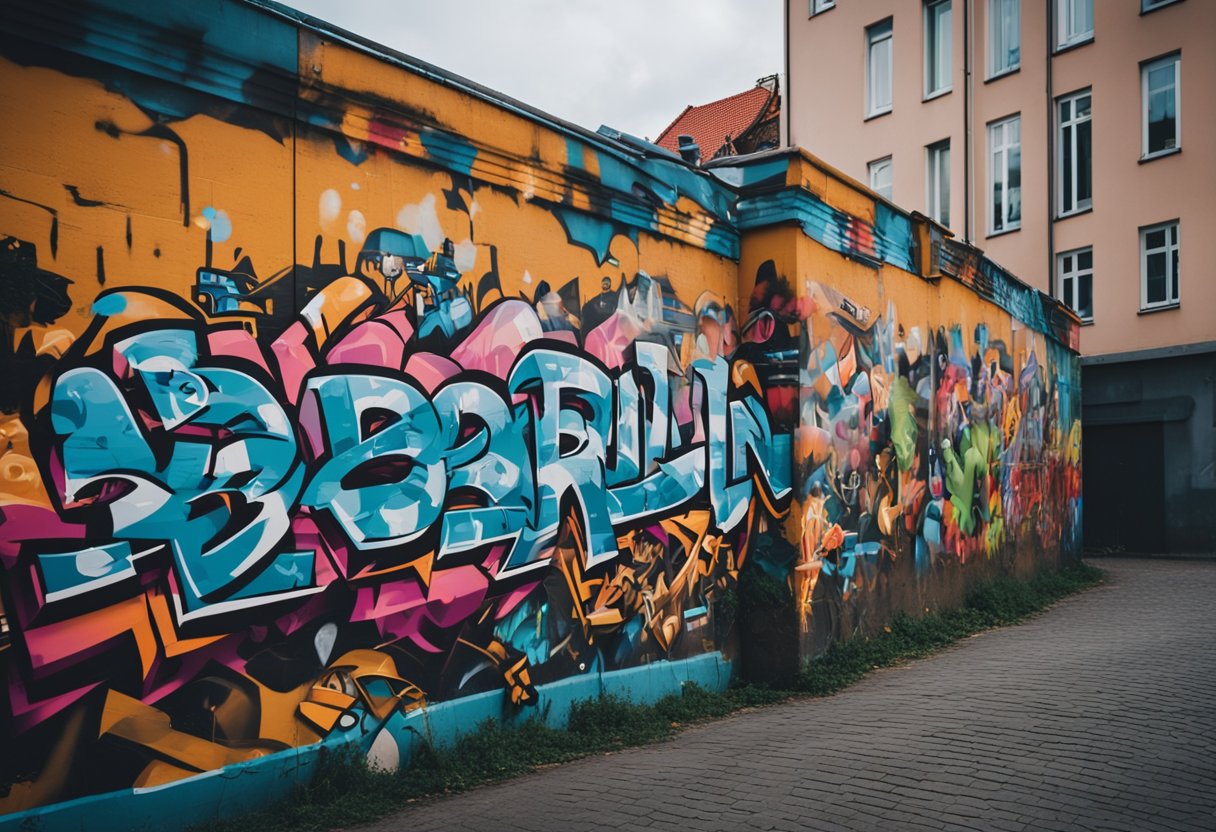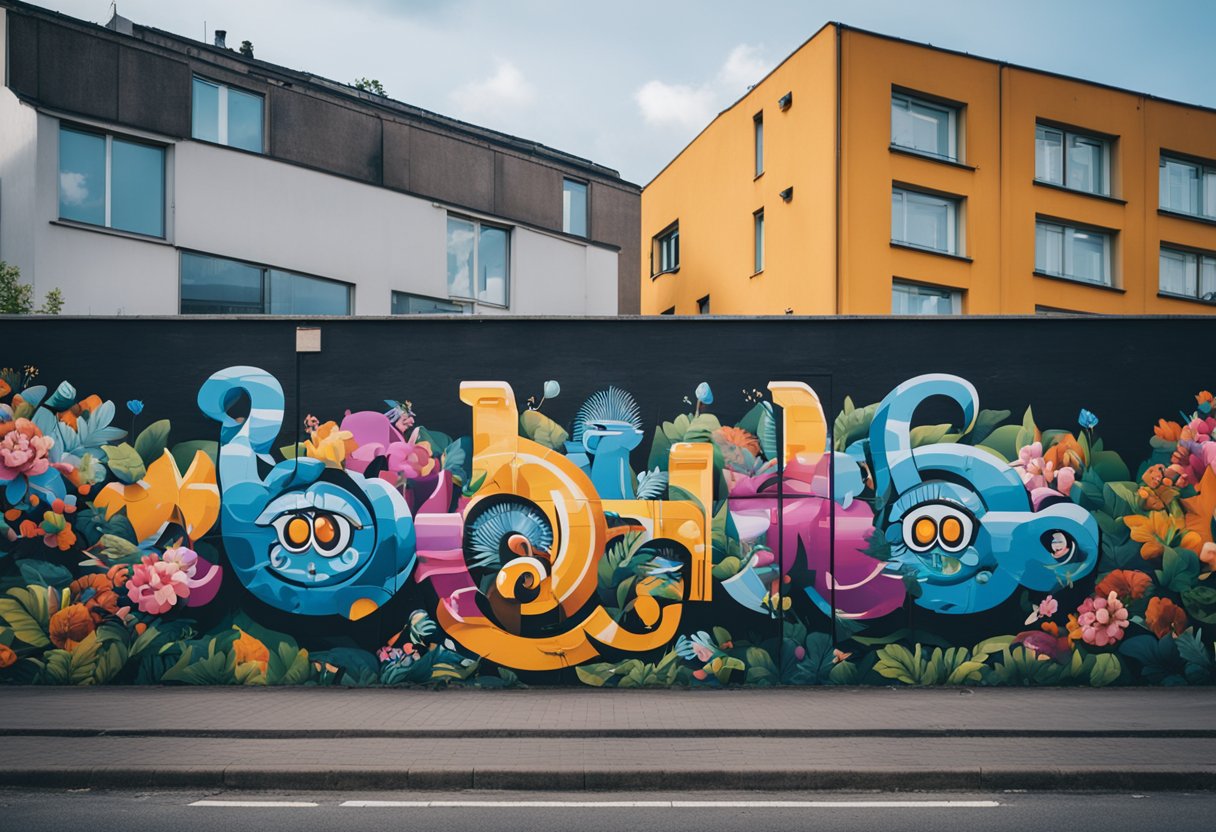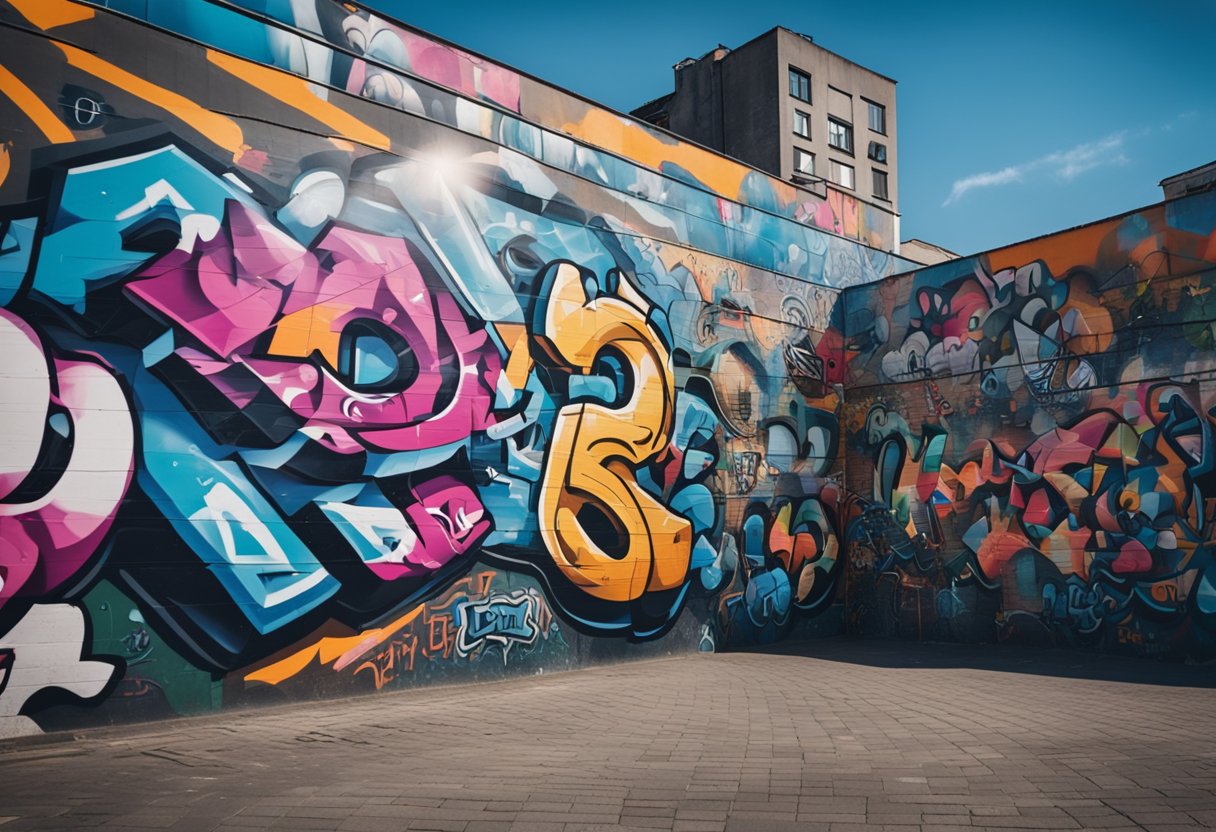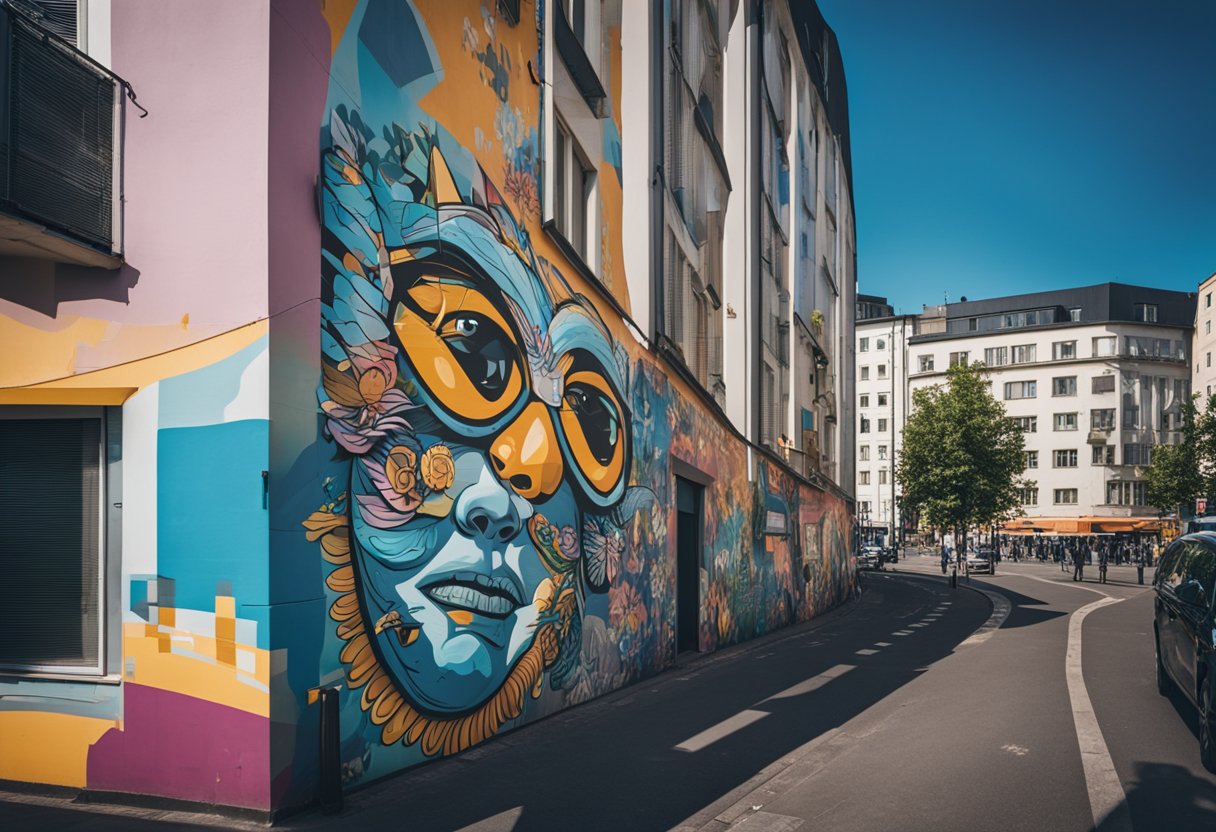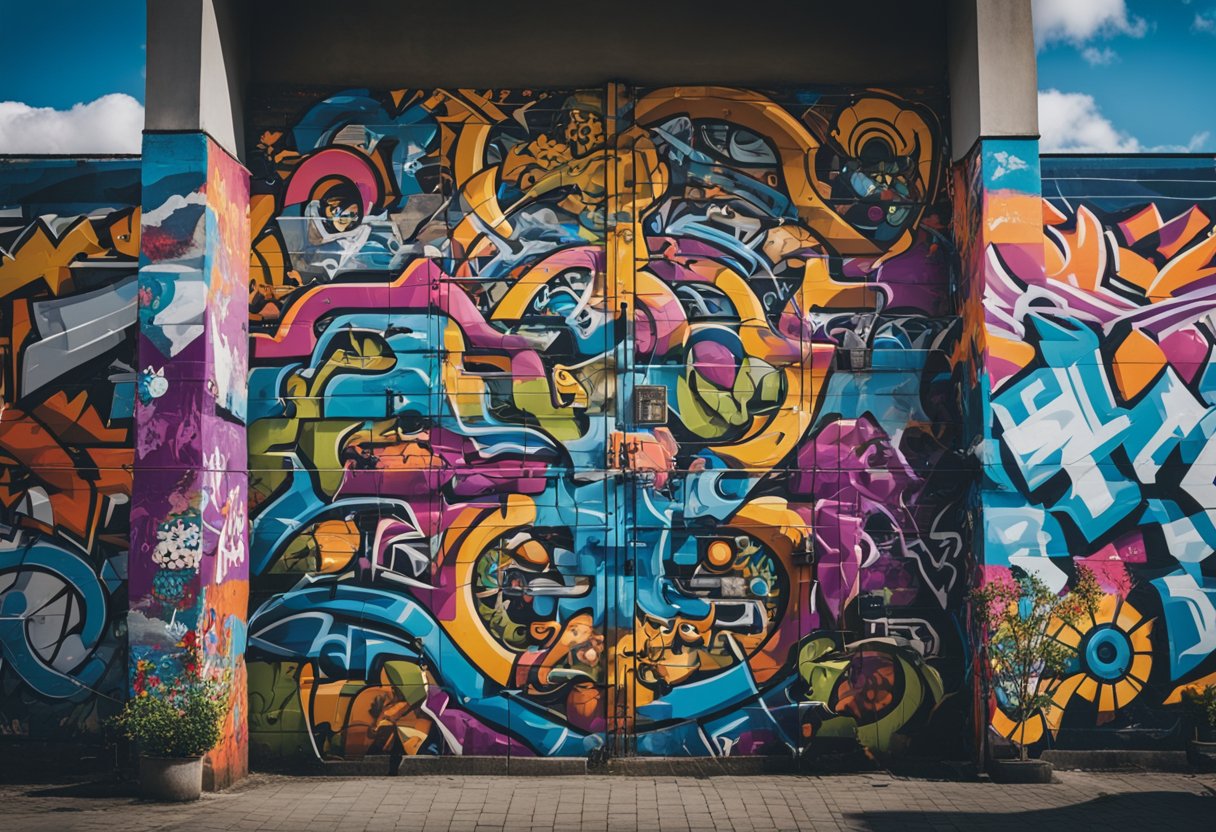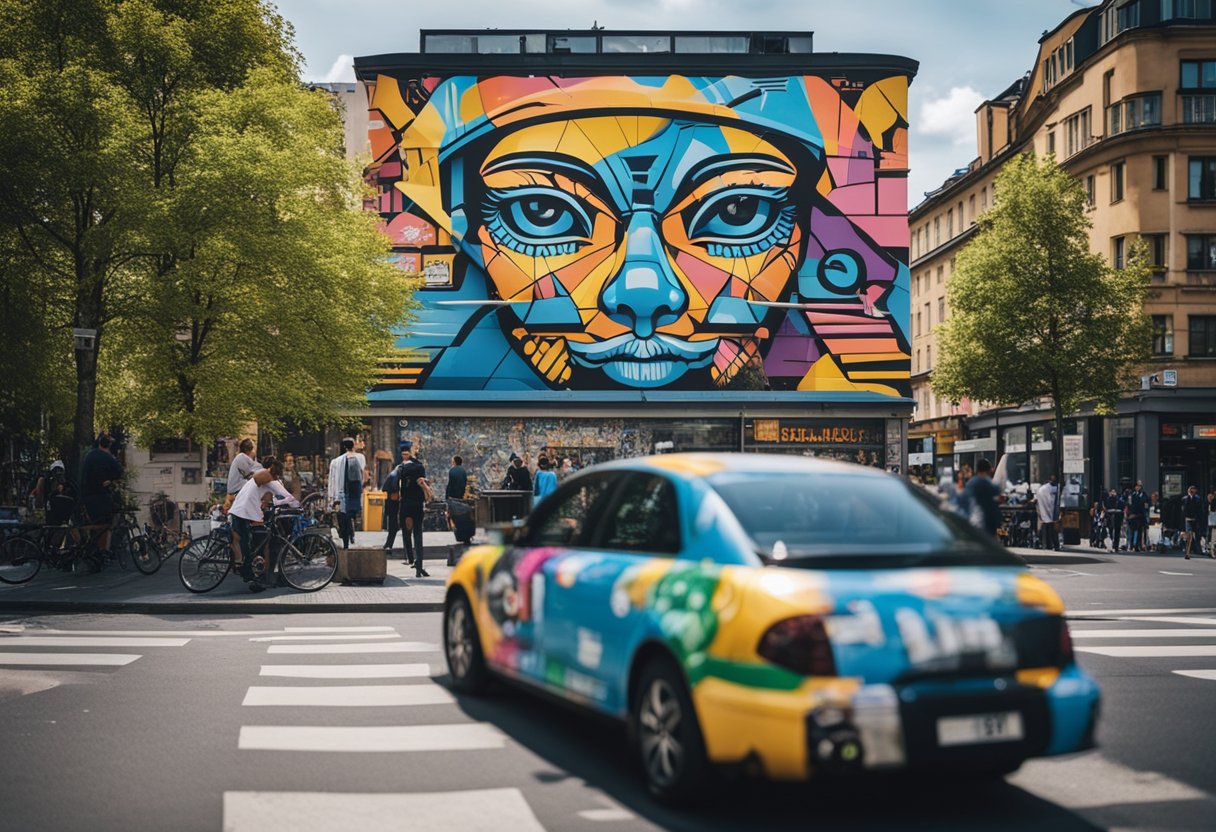Berlin’s urban landscape tells a vivid story through its vibrant street art and graffiti, which have become an integral part of the city’s cultural fabric.
From the remnants of the Berlin Wall to the hidden corners of its urban neighborhoods, Street Art Berlin as a canvas that carries the weight of history while also pulsing with a very contemporary form of expression.
- Berlin is home to over 2,500 street art murals.
- Approximately 30% of Berlin’s neighborhoods are covered in street art.
- Over 40% of tourists visiting Berlin prioritize exploring its street art scene.
- The East Side Gallery, a stretch of the Berlin Wall covered in murals, attracts more than 1 million visitors annually.
- Street art tours in Berlin have experienced a 50% increase in popularity over the past five years.
We observe that street art in Berlin goes beyond mere aesthetics; it is a form of social commentary and a testament to freedom of expression. Iconic murals by artists like Dmitri Vrubel at the East Side Gallery stand as silent witnesses to the city’s tumultuous past while inspiring a dynamic future. In neighborhoods like Kreuzberg and Friedrichshain, we find the streets alive with the works of international and local artists, each piece contributing to a larger conversation about identity, politics, and community.
As we navigate through the streets of Berlin, the influence of street culture is undeniable in the ever-evolving art forms that grace its walls. Whether it is through the colorful tags and lettering inspired by the hip-hop culture of the ’70s or the modern form of urban art that sprawls across the city, it’s evident that Berlin embraces its role as an open gallery of public expression, challenging and inspiring those who wander its streets.
History of Street Art in Berlin
As we explore the rich tapestry of Berlin’s street art, it is essential to understand its origins, marked by the tension of the Cold War, the division created by the Berlin Wall, and the city’s reclamation of its urban spaces through artistic expression.
Berlin Wall and Graffiti
Our journey into Berlin’s street art history invariably begins with the Berlin Wall, inaugurated in the cold environment of the Cold War as a physical and ideological divide. The west side of the Wall became a canvas for defiant artists, with graffiti art emerging as a powerful form of protest and expression. It was here that one of the most iconic murals, the Fraternal Kiss, was painted by Dmitri Vrubel, depicting Leonid Brezhnev and Erich Honecker locked in a socialist fraternal embrace, also often referred to as the Fraudulent Kiss.
Evolution Post-Cold War
Following the fall of the Wall in 1989, graffiti art found new meaning within a reunified Berlin. The East Side Gallery, a long-standing section of the Wall, transformed into an open-air mural exhibition, symbolizing freedom and the end of the Cold War. This era saw an explosion of artwork as artists from both sides of the former divide, and indeed from all over the world, claimed the city as their canvas.
International Influence
Berlin’s street art scene did not just evolve; it soared, drawing in artists globally and establishing itself as a vital hub for urban artistry. This infusion of international influence further cemented Berlin’s reputation as a city synonymous with graffiti and street art, evolving beyond its turbulent past to embrace a myriad of styles and messages inherent to this dynamic art form.
Key Areas for Street Art
We find Berlin’s street art scene vibrant and constantly evolving, with several key areas in the city standing out as hubs for graffiti, murals, and street art installations. These places not only reflect the city’s dynamic art culture but also its history and socio-political narratives.
Kreuzberg and Friedrichshain
In Kreuzberg, Oranienstraße is a hotspot for street art wherein every turn offers a canvas displaying the creativity of local and international artists. Moving on to Friedrichshain, the RAW Gelände is rich with gritty urban art and murals by iconic artists. These districts are beloved for their rebellious spirit evident in the vivid artworks adorning their streets and alleyways.
- Oranienstraße: A canvas of urban creativity
- Friedrichshain: Home to large scale murals
Mitte and Urban Nation Area
Mitte showcases a mix of historical landmarks and contemporary street art. A must-visit is the Haus Schwarzenberg Street Art Alley, which is a treasure trove of eclectic art pieces. The Urban Nation museum in the area is a renowned institution dedicated to celebrating urban art where the exterior itself is a testimony to the talent it encapsulates.
- Mitte: A blend of the historical and contemporary
- Urban Nation: An institution celebrating urban art
Teufelsberg Listening Station
The Teufelsberg Listening Station stands as a relic of the Cold War, now repurposed as a canvas for street art. Its history as a former American listening post adds layers of context to the artwork peppered across the dilapidated structures. The panoramic views of the city complement the experience, making it a unique spot for street art enthusiasts.
- Teufelsberg: Historic canvases on a panoramic backdrop
Throughout these areas, the Spree river bank and Mauerpark also serve as backdrops for dynamic street art expressions, contributing to the city’s reputation as a canvas that captures the zeitgeist.
Notable Artists and Works
Berlin’s street art scene boasts an impressive array of works by both homegrown talent and international maestros. We’ll explore the significant contributions in the realms of urban art, delving into masterpieces that dance upon the city’s walls.
German and Berlin-Based Artists
- Thierry Noir: Famed for his colorful silhouettes on the Berlin Wall, Noir is considered one of the pioneers of the modern street art movement.
- El Bocho: Recognized for his ‘romantic’ street art, El Bocho’s work adds vibrant hues to Berlin, aiming to enhance the city’s beauty. You can find more details about his signature style here.
- Herakut: The artist duo’s murals often incorporate human figures with poignant messages, resonating deeply with their audience.
- Alias: His smaller, subtly-placed works often explore themes of childhood and innocence, requiring a keen eye to spot.
International Artist Contributions
- Victor Ash: His astronaut mural is notably one of Berlin’s most iconic pieces, reflecting themes of adventure and discovery.
- ROA: Known for his large-scale depictions of animals, ROA’s art can be seen breathing wild life onto Berlin’s urban canvas.
- Blu: With massive murals that often carry political messages, Blu’s artwork is as thought-provoking as it is prolific.
- Os Gêmeos: The Brazilian twin brothers’ distinctive yellow characters bring a slice of South American vibrancy to the streets of Berlin.
- Shepard Fairey: This American artist’s ‘Obey’ campaign has also found its way onto Berlin’s facades, epitomizing the global interconnectedness of street art.
- JR: His engaging and immersive installations have turned entire buildings in Berlin into storytelling canvases.
- Banksy: Although more secretive, Banksy’s satirical and poignant works have also graced Berlin, adding to the rich tapestry of street art in the city.
- Otto Schade: His signature ribbon style creates intricate forms and figures that captivate and challenge viewers.
Street Art Forms and Techniques
Berlin’s street art scene is a vibrant tableau, reflecting a variety of artistic expressions. We see everything from sprawling murals to subtle paste-ups and innovative sculptures transforming the city’s urban fabric.
Murals and Large-Scale Works
Berlin is famed for its murals. These large-scale works can be found on the sides of buildings and often convey powerful social and political messages. One Wall projects, for instance, invite artists to create a mural on one designated wall, often resulting in breathtaking and conversation-sparking pieces. A significant location that houses such murals is Haus Schwarzenberg, a cultural beacon housing some of the city’s most impressive artworks.
Stickers, Paste-Ups, and Sculptures
Moving beyond traditional spray-painted graffiti, we find stickers and paste-ups as a quick form of street art. These pieces are easier to install and can be as transient or enduring as the surface allows. Sculptures add a three-dimensional element to Berlin’s street art, challenging our perceptions of public space and art interaction. Whether clinging to lampposts or perched on buildings, these artworks compel us to observe our surroundings with a keener eye.
Cultural Impact and Legal Aspects
Berlin’s street art is a testament to our city’s dynamic culture and history. As we explore the balance between legality and expression, and the influence on urban development, we highlight the complexities of street art in social and legal contexts.
Freedom of Expression Vs. Vandalism
Street art in Berlin serves as a pillar of freedom of expression, acting as a voice for the city’s sociopolitical discourse. The cityscape showcases works that range from spontaneous tags to commissioned murals, blurring the lines between art and vandalism. Notably, Warschauer Straße has become a canvas signifying this debate; whilst much of the art there is unsanctioned, it’s recognized globally for its cultural significance.
However, Berlin has legal frameworks distinguishing vandalism from sanctioned street art. The East Side Gallery stands as a prime example of legal street art, having been transformed from a symbol of division into one of unity and free expression. It’s not just a gallery but a historical monument protected by law.
Gentrification and Urban Transformation
Gentrification is a complex process affecting Berlin’s neighborhoods as they evolve. Street art is often an indicator of urban transformation, sometimes leading to increased property values and reshaped communities. For instance, areas like the district around Urban Spree have been heavily influenced by both street art culture and the rapid pace of urban development.
This transformation is multifaceted: while street art can lead to the beautification of areas, attracting new businesses and residents, it can also spur displacement and loss of the local character that originally fostered the art scene. We witness an evolution of the district, where street art is playing a pivotal role in shaping both its physical appearance and cultural identity.
Street Art Tours and Experiences
Berlin’s vibrant street art culture is best experienced through its array of tours and workshops. We’ll guide you through options that range from intimate guided explorations to independent adventures in the city’s eclectic art scene.
Guided Tours and Workshops
Guided Walking Tours: Embark on a Berlin Graffiti Tour to witness iconic murals and clandestine stencils that tell the story of the city’s rich history. Each tour gives you an insider’s look at works by celebrated street artists, including the notorious Berlin Kidz, whose daring stunts and poignant pieces are recognized worldwide.
Bike Tours: For those who prefer a faster pace, bike tours offer a unique perspective on Berlin’s street art. They allow us to cover more ground and experience the larger-than-life murals adorning the RAW Gelände, a former railway yard turned cultural hub.
Graffiti Workshops: If you’re keen on getting hands-on experience, consider joining a graffiti workshop. These sessions are perfect for learning the techniques and nuances of creating street art, offering a deeper appreciation for the works that dot Berlin’s landscape.
Self-Guided Exploration
For the free-spirited, self-guided exploration allows you to discover Berlin’s street art at your own pace. Areas like Kreuzberg and Friedrichshain are bustling with street art, and hidden gems can often be found with a keen eye and a bit of luck. Be sure to check out local flea markets; sometimes the street art isn’t just on the walls but available for purchase as well. While wandering, look out for pieces from well-known collectives like the Berlin Kidz for a true taste of the city’s creative pulse.
Preservation and Future of Street Art
In Berlin, the evolution of street art has become a vital part of the city’s cultural identity, reflecting a rich history and a progressive attitude towards urban creativity. Efforts to safeguard this art form are gaining traction amidst discussions on its impermanence and the role it plays in public spaces.
Conservation Efforts
We see an increasing number of street art pieces being preserved for posterity. The Urban Nation Museum for Urban Contemporary Art showcases not only local but also international street art and plays a central role in the protection of these artworks. Through initiatives like the ONE WALL project, urban artists are invited to create large-scale murals, elevating street art to a museum-grade phenomenon. These murals are not only protected by their association with the museum but also act as a catalyst for discussions about preservation. Moreover, UNESCO’s designation of Berlin as a City of Design recognizes and encourages the conservation of street art as a significant part of the city’s artistic heritage.
The Role of Art in Public Spaces
In Berlin, street art is more than decoration; it is a form of cultural dialogue with the public. We consider our street art as a dynamic component of urban life that challenges, educates, and interacts with viewers on a daily basis. This form of expression is part of what earned us the UNESCO City of Design title, reflecting our commitment to fostering creative output. Street art’s impermanence is perhaps what compels viewers to engage with it more deeply, knowing that it might not be there tomorrow. It’s a living history of the city, with walls acting as a canvas that narrates our evolving story. We believe the role of street art in our public spaces is to stimulate conversation, inspire change, and to reflect the energy and diversity of Berlin.
Street Art in Berlin’s Urban Landscape
As we explore Berlin’s vibrant urban tapestry, it becomes evident that the street art adorning the city’s walls is not a random occurrence but a defining component of its character. This art form has transformed neighborhoods and become inextricably linked with the city’s architecture.
Influence on Neighborhoods and Markets
In neighborhoods like Boxhagener and Oranienstraße, we observe how street art is more than mere decoration; it’s a dialogue with the local community. These places have seen an uptick in visitors and residents, keen on experiencing the distinctive atmospheres that these painted visuals contribute to. Warschauer Straße becomes an impromptu gallery with pedestrians pausing to engage with works from artists like El Bocho, whose trademark “Little Lucy” series—often involving wit and dead animals—catches the eye.
Markets in these areas, known for their bohemian spirit, have also experienced a renaissance. It’s common to spot visitors and locals alike, negotiating the sales of street art prints or related paraphernalia, cementing the art’s influence on the local economy.
Integration with the City’s Architecture
Our journey takes us to key architectural landmarks like the Frankfurter Tor and Oberbaumbrücke, which stand as sentinels to an open-air exhibit of human creativity. At Holzmarkt, an eclectic architectural marvel, street art converges with the structures in a seamless blend, creating a holistic visual experience that reflects the city’s historical and cultural journey.
The street art in Berlin doesn’t just complement the city’s architecture; in many cases, it narrates the city’s past, present, and aspirations. The way murals wrap around the buildings’ corners or how a stencil might silently accentuate a historical facade speaks to our collective ability to integrate art into our daily lives, allowing it to become as much a part of Berlin’s urban landscape as the buildings themselves.
Famous Street Art Events and Festivals
Berlin’s street art scene is vibrant and renowned worldwide, hosting events that attract artists and enthusiasts from Europe and beyond. Our city is a canvas for urban expression, showcasing a medley of artwork from local talents and international artists.
Annual Gatherings and Showcases
- Urban Nation – Berlin’s hub for contemporary street art. This organization not only operates a unique museum dedicated to urban art, but also curates a plethora of events throughout the year. We witness an exceptional assembly of street art during their festivals, where artists from diverse regions, including Brazil, Spain, and New York, grace the walls of Berlin with their original works.
- The Berlin Mural Fest – An event where street art is celebrated at a grand scale, often featuring murals that stretch across large facades. This festival offers a platform for international artists to collaborate and exhibit their skills, enhancing the cultural tapestry of our city.
- Berlin’s Festival of Lights – While not exclusively a street art festival, this event illuminates the city’s architecture with light installations and projections, some of which are reminiscent of the powerful impact of street art. It serves as a testament to Berlin’s love for public art, bridging the gap between traditional art forms and street-inspired creations.
By focusing on these events, we experience a fusion of cultures and ideas that solidify our position as a street art capital of Europe.
